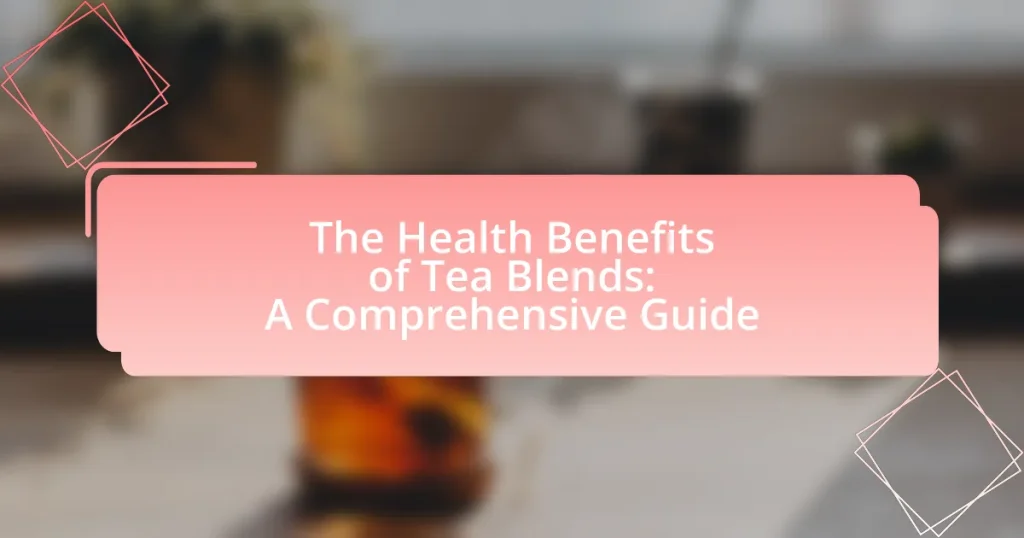Tea blends are combinations of various tea leaves, herbs, spices, and flavoring agents that create unique flavors and offer potential health benefits. This comprehensive guide explores the composition of tea blends, including the types of tea leaves commonly used, the role of herbs and spices, and the health benefits associated with different blends. It also covers the creation process of tea blends, best practices for brewing, and how to incorporate them into daily routines for optimal health outcomes. Additionally, the article highlights specific blends for relaxation, weight management, and digestive health, supported by scientific research on their effectiveness.

What are Tea Blends and Their Composition?
Tea blends are combinations of different types of tea leaves, herbs, spices, and other flavoring agents designed to create unique flavors and potential health benefits. The composition of tea blends typically includes a base tea, such as black, green, or oolong, combined with various ingredients like dried fruits, flowers, or essential oils to enhance taste and aroma. For example, a popular blend might consist of green tea mixed with jasmine flowers, which not only provides a distinct flavor but also offers additional antioxidants. The careful selection of these components allows for a diverse range of flavors and health properties, making tea blends a versatile choice for consumers seeking both enjoyment and wellness benefits.
How are tea blends created?
Tea blends are created by combining different types of tea leaves and additional ingredients such as herbs, spices, or fruits to achieve a desired flavor profile and health benefits. The process typically involves selecting base teas, such as black, green, or herbal, and then experimenting with various proportions of complementary ingredients to enhance taste and aroma. For example, a blend might include green tea for its antioxidants, combined with mint for flavor and digestive benefits. This method allows for the creation of unique blends that cater to specific health needs or preferences, supported by the fact that different tea components can interact synergistically to enhance their individual properties.
What types of tea leaves are commonly used in blends?
Commonly used tea leaves in blends include black tea, green tea, oolong tea, and white tea. Black tea serves as a robust base for many blends due to its strong flavor and high caffeine content, while green tea adds a fresh, grassy note and is known for its health benefits, including antioxidants. Oolong tea, with its partially oxidized leaves, contributes a unique flavor profile that can range from floral to fruity, and white tea, being the least processed, offers a delicate taste and high antioxidant levels. These types of tea leaves are frequently combined to create balanced flavors and enhance the health benefits associated with tea consumption.
What role do herbs and spices play in tea blends?
Herbs and spices enhance tea blends by adding unique flavors, aromas, and potential health benefits. For instance, herbs like chamomile can promote relaxation, while spices such as ginger may aid digestion and boost immunity. The incorporation of these ingredients not only diversifies the sensory experience of tea but also contributes to its therapeutic properties, as evidenced by studies showing that herbal infusions can have anti-inflammatory and antioxidant effects.
What are the different types of tea blends?
The different types of tea blends include black tea blends, green tea blends, herbal tea blends, oolong tea blends, and white tea blends. Black tea blends often combine various black teas or include flavorings like spices or fruits, while green tea blends may incorporate herbs or floral elements to enhance flavor. Herbal tea blends consist of various herbs, spices, and fruits, providing caffeine-free options. Oolong tea blends typically mix oolong with other teas or flavors, and white tea blends often feature delicate white tea combined with fruits or flowers. Each type of blend offers unique flavor profiles and potential health benefits, such as antioxidants and relaxation properties.
How do flavored tea blends differ from traditional blends?
Flavored tea blends differ from traditional blends primarily in their inclusion of additional flavoring agents, such as fruits, spices, or herbs, which enhance the taste profile. Traditional blends typically consist of pure tea leaves, such as black, green, or oolong, without any added flavors. The incorporation of these flavoring agents in flavored blends can lead to a wider variety of taste experiences and may also introduce unique health benefits associated with the added ingredients, such as antioxidants from fruits or anti-inflammatory properties from spices.
What are some popular herbal tea blends and their ingredients?
Popular herbal tea blends include chamomile-lavender, peppermint-ginger, and hibiscus-rose. Chamomile-lavender tea typically consists of dried chamomile flowers and lavender buds, known for their calming effects. Peppermint-ginger tea combines peppermint leaves and ginger root, which can aid digestion and provide a refreshing flavor. Hibiscus-rose tea features hibiscus petals and dried rose petals, offering a tart taste and potential benefits for heart health. These blends are widely recognized for their unique flavors and health-promoting properties.

What Health Benefits Do Tea Blends Offer?
Tea blends offer a variety of health benefits, including improved heart health, enhanced mental clarity, and increased antioxidant intake. Specific tea blends, such as green tea with lemon, can lower cholesterol levels and reduce the risk of heart disease due to their high levels of catechins. Additionally, herbal blends like chamomile and peppermint can aid digestion and promote relaxation, contributing to overall well-being. Research indicates that the antioxidants found in tea blends can combat oxidative stress, which is linked to chronic diseases. For instance, a study published in the Journal of Nutritional Biochemistry found that regular consumption of tea can significantly reduce the risk of developing cardiovascular diseases.
How do tea blends contribute to overall health?
Tea blends contribute to overall health by combining various beneficial ingredients that enhance their nutritional profile. These blends often include a mix of herbs, spices, and traditional tea leaves, which can provide antioxidants, anti-inflammatory properties, and essential vitamins. For instance, green tea is rich in catechins, which have been shown to improve heart health and reduce the risk of chronic diseases. Additionally, herbal components like ginger and turmeric can aid digestion and boost the immune system. Studies indicate that regular consumption of tea blends can lead to improved metabolic health and reduced stress levels, further supporting overall well-being.
What antioxidants are found in tea blends and how do they benefit health?
Tea blends contain several antioxidants, primarily catechins, flavonoids, and polyphenols, which contribute to various health benefits. Catechins, such as epigallocatechin gallate (EGCG), are known for their ability to reduce inflammation and lower the risk of chronic diseases, including heart disease and cancer. Flavonoids, found in both green and black tea, help improve cardiovascular health by enhancing blood vessel function and reducing blood pressure. Polyphenols, abundant in herbal tea blends, possess anti-inflammatory and antioxidant properties that support overall health by combating oxidative stress. Research indicates that regular consumption of tea can lead to improved metabolic health and a lower incidence of certain diseases, reinforcing the significance of these antioxidants in promoting well-being.
How can tea blends support mental well-being?
Tea blends can support mental well-being by providing a combination of calming and uplifting effects through their diverse ingredients. For instance, blends containing chamomile and lavender are known for their anxiety-reducing properties, while those with green tea can enhance focus and cognitive function due to their caffeine and L-theanine content. Research indicates that L-theanine, an amino acid found in tea, promotes relaxation without drowsiness, which can improve overall mood and mental clarity. Additionally, the ritual of preparing and consuming tea can serve as a mindfulness practice, further contributing to mental health benefits.
What specific health benefits are associated with different tea blends?
Different tea blends offer a variety of specific health benefits. Green tea is known for its high antioxidant content, particularly catechins, which can enhance metabolism and support weight loss. Black tea contains flavonoids that may improve heart health by reducing cholesterol levels and improving blood vessel function. Herbal teas, such as chamomile, are recognized for their calming effects and can aid in sleep and digestion. Rooibos tea is caffeine-free and rich in antioxidants, which may help reduce inflammation and promote skin health. Each blend’s unique composition contributes to its specific health benefits, supported by studies indicating their positive effects on various health conditions.
Which tea blends are known for boosting the immune system?
Echinacea tea blends are known for boosting the immune system. Echinacea contains compounds that may enhance immune function by increasing the production of white blood cells, which are crucial for fighting infections. Additionally, green tea blends, rich in antioxidants like catechins, have been shown to support immune health by reducing inflammation and enhancing the body’s defense mechanisms. Research indicates that the polyphenols in green tea can inhibit the growth of pathogens, further contributing to immune support.
How do certain tea blends aid in digestion?
Certain tea blends aid in digestion by incorporating ingredients known for their digestive properties, such as ginger, peppermint, and fennel. Ginger stimulates saliva and bile production, enhancing the digestive process, while peppermint relaxes the muscles of the gastrointestinal tract, alleviating symptoms of bloating and discomfort. Fennel seeds contain compounds that can reduce gas and bloating, promoting smoother digestion. Research has shown that these ingredients can effectively improve digestive health, with studies indicating that ginger can reduce nausea and peppermint can relieve irritable bowel syndrome symptoms.

How Can You Incorporate Tea Blends into Your Daily Routine?
To incorporate tea blends into your daily routine, start by selecting specific times for tea consumption, such as morning, afternoon, or evening. This structured approach allows you to enjoy the unique benefits of different blends; for example, a green tea blend in the morning can enhance alertness due to its caffeine content, while a chamomile blend in the evening can promote relaxation and better sleep. Additionally, consider replacing one of your daily beverages, like coffee or sugary drinks, with a tea blend to reduce caffeine intake and sugar consumption, which can contribute to overall health improvements. Research indicates that regular tea consumption can lower the risk of chronic diseases, such as heart disease and diabetes, due to the antioxidants present in tea blends.
What are the best practices for brewing tea blends?
The best practices for brewing tea blends include using the right water temperature, steeping time, and tea-to-water ratio. For optimal flavor extraction, different tea types require specific temperatures; for example, green tea is best brewed at 160-180°F, while black tea should be brewed at 200-212°F. Steeping times also vary, with green tea needing about 2-3 minutes and black tea around 3-5 minutes. A general guideline for tea-to-water ratio is one teaspoon of loose leaf tea per 8 ounces of water. Following these practices ensures a balanced and flavorful cup, enhancing the health benefits associated with tea blends, such as antioxidants and improved hydration.
How does water temperature affect the flavor and benefits of tea blends?
Water temperature significantly influences the flavor and health benefits of tea blends. Different types of tea require specific temperature ranges to extract optimal flavors and beneficial compounds; for instance, green tea is best brewed at 160-180°F (70-80°C) to preserve its delicate flavors and antioxidants, while black tea benefits from higher temperatures of 200-212°F (93-100°C) to fully release its robust flavors and polyphenols. Studies indicate that brewing tea at the correct temperature enhances the bioavailability of catechins and flavonoids, which are linked to various health benefits, including improved heart health and reduced inflammation. Therefore, using the appropriate water temperature is crucial for maximizing both the sensory experience and the health advantages of tea blends.
What is the ideal steeping time for various tea blends?
The ideal steeping time for various tea blends varies by type. For black tea, the recommended steeping time is 3 to 5 minutes; for green tea, it is 2 to 3 minutes; for oolong tea, it is 4 to 7 minutes; for white tea, it is 4 to 5 minutes; and for herbal tea, it is typically 5 to 7 minutes. These times are based on the optimal extraction of flavors and beneficial compounds, ensuring the best taste and health benefits.
What tips can enhance your experience with tea blends?
To enhance your experience with tea blends, focus on selecting high-quality ingredients and experimenting with steeping times and temperatures. High-quality tea leaves and herbs contribute to richer flavors and better health benefits, as studies show that fresh ingredients retain more antioxidants. Additionally, adjusting steeping times and temperatures allows you to discover the optimal flavor profile for each blend, as different teas release their compounds at varying rates. For example, green tea typically requires lower temperatures and shorter steeping times compared to black tea, which can enhance the overall taste and health benefits of your tea experience.
How can you pair tea blends with food for optimal enjoyment?
To pair tea blends with food for optimal enjoyment, consider the flavor profiles of both the tea and the dish. For example, a robust black tea complements hearty meals like red meats, while a delicate green tea pairs well with lighter dishes such as fish or salads. This pairing is supported by the principle that similar flavor intensities enhance the overall dining experience, as noted in culinary studies which emphasize balance in taste. Additionally, herbal teas can enhance desserts, with chamomile tea harmonizing with sweet pastries, creating a cohesive flavor experience.
What are some common mistakes to avoid when preparing tea blends?
Common mistakes to avoid when preparing tea blends include using incorrect water temperature, oversteeping the tea, and not measuring ingredients accurately. Using water that is too hot can scorch delicate leaves, while oversteeping can lead to bitterness. Accurate measurements ensure a balanced flavor profile, as too much or too little of an ingredient can disrupt the intended taste. These practices are essential for achieving the desired flavor and health benefits associated with tea blends.
What are the best tea blends for specific health goals?
The best tea blends for specific health goals include green tea with lemon for weight loss, chamomile and peppermint for digestive health, and ginger and turmeric for inflammation reduction. Green tea contains catechins that boost metabolism, while lemon enhances its fat-burning properties. Chamomile and peppermint are known for their soothing effects on the digestive system, helping to alleviate bloating and discomfort. Ginger and turmeric are rich in anti-inflammatory compounds, making them effective for reducing inflammation and pain. These blends are supported by studies highlighting their respective health benefits, such as the role of green tea in weight management (Hursel et al., 2011) and the anti-inflammatory effects of ginger and turmeric (Zhang et al., 2016).
Which tea blends are recommended for relaxation and stress relief?
Chamomile tea, lavender tea, and lemon balm tea are recommended for relaxation and stress relief. Chamomile contains apigenin, an antioxidant that binds to receptors in the brain, promoting sleepiness and reducing anxiety. Lavender tea is known for its calming effects, supported by studies indicating that it can decrease heart rate and improve mood. Lemon balm tea has been shown to reduce stress and improve cognitive function, as evidenced by research published in the journal “Nutritional Neuroscience,” which found that it can significantly lower anxiety levels.
What tea blends can help with weight management?
Green tea blends, such as those containing matcha or sencha, can significantly aid in weight management due to their high levels of catechins, which boost metabolism and fat oxidation. Research published in the American Journal of Clinical Nutrition indicates that green tea extract can enhance fat burning during exercise, leading to improved weight loss outcomes. Additionally, oolong tea blends have been shown to increase energy expenditure and fat oxidation, as supported by a study in the Journal of Nutrition, which found that participants consuming oolong tea experienced greater fat loss compared to those who did not. Herbal blends like rooibos and hibiscus also contribute to weight management by reducing fat accumulation and improving metabolic health, as evidenced by studies highlighting their antioxidant properties and effects on blood sugar regulation.


